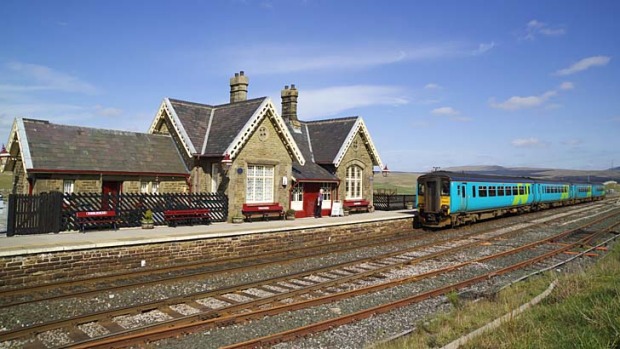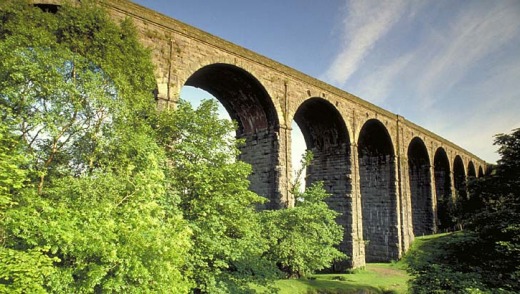
If you snooze you lose; this is one of England's most treasured rail routes.
When travelling on a long-distance passenger train it always pays to mind the gap. That's not just the one that exists between the carriage and the platform but that divide that forever exists between the tourist riding for pleasure and the local travelling for purpose. For the engaged tourist, after all, everything is brilliantly new and absorbing while for the indifferent local everything is old and prosaic.
The tourist stays alert for the whole journey, not wishing to miss a single landmark or a piece of scenery, while the local sleeps through of much of it as he or she possibly can. For me this rule, after a lifetime of train travel, has rarely been more apposite than my journey on what is widely considered one of England's most scenic, and treasured, rail routes.

I refer to the line that extends between the towns of Carlisle in Cumbria and Settle in the Yorkshire Dales, and if not for the successful thwarting of British Rail's attempts to close the historic route I may not be enjoying the privilege of riding on it at all. It was only a public outcry in the 1980s that saved the line. Today there are as many as eight services a day and I'm on one of them.
Such is the passion engendered by the Settle to Carlisle Line that earlier this year a special train ran to commemorate the 25th anniversary of the railway's rescue. Those who campaigned for the retention of the line were vindicated since it's now an important freight and passenger route with millions of pounds having been spent on the upgrade of its tracks.
It's a Sunday afternoon and the train is packed with weekend commuters heading home for the impending working week. My journey, with my ultimate destination being Leeds, began earlier in the day in Glasgow. As a result, I've approached the Settle-Carlisle Line from the north with lunch at the railway hotel adjoining the Carlisle Station. The city is overlooked by a castle that was once home to Mary Queen of Scots while Hadrian's Wall was a defensive fortification begun in AD 122 during the rule of the Roman emperor Hadrian.
There's a bus - suitably numbered AD122 - which leaves daily in summer for Hadrian's Wall, departing directly outside Carlisle Station, while the Lake District is nearby as well. But I had a train, not a bus, to catch and, there's nowhere to store my luggage so, regrettably, there's no time for sightseeing. Instead I settle in for an agreeable lunch at the restored Hallmark Carlisle railway hotel and wait for my train.
After lunch I head the short distance back to the station for my journey on the 117 kilometre-long Settle to Carlisle Line. The railway, which was completed in 1876, presented a tremendous challenge to its Victorian-era engineers since its construction required 325 bridges, 20 major viaducts and 14 tunnels, some more than two kilometres long.
But the most famous engineering feat is Ribblehead Viaduct, sounding like something out of a Harry Potter book, which consists of 24 majestic arches. Not even Ribblehead can arouse the interest of my dozy fellow passengers, unfussed by the glories of the classic English countryside and the small towns and villages flashing by. Below us I notice a lone vehicle parked with the occupants, tripod propped up on the mossy ground, capturing the money shot of the train as it passes along the viaduct.
Everywhere ancient dry stone walls climb and dip over undulating meadows, green as a brand new billiard-table cloth, and are intersected by towns that each look like they could easily serve as locations for a bucolic BBC drama. In the carriage there's the incessant sound of rolling dice behind from a game being played by two friends as the sun of the ungenerously short late autumn day begins to rapidly dissolve over hills so smooth in the weakening light that they resemble lumps of rolled dough.
The Settle to Carlisle Line traverses the North Pennines. The Pennines, known as "the backbone of England", never rising any higher than 900 metres, are puny by world standards but to the English this is a remote and thinly populated corner of the country.
The train is a godsend for walkers who use it as transport between key points and this is no less evident than on a Sunday like this one when they drag their weary bodies on to the train at the end of energetic weekends.
Local produce could be transported with ease to many cities and towns around the country. Many of the stations along the Settle to Carlisle line feature goods sheds that once dispatched and received a variety of produce destined for markets in the cities.
Soon, as the inevitable rain begins to spit on the windows of my carriage, it'll be nearly as dark outside as one of the old tunnels through which the train dashes. Silvery streaks of water from brooks and streams stand out in the murky light as the puffs of smoke from farmhouse chimneys grow ever more intense with the cold of the impending evening.
My personal timetable doesn't allow it but it's possible to stay at the station at Kirkby Stephen, a historic market town. Each of the stations, painted red and white and built of brick and wrought-iron, have been meticulously and lovingly restored by volunteer rail enthusiasts. "Settle Station Signal Box restored by friends of the line," reads a sign. It's possible to take a tourist train along the Settle to Carlisle Line but this is a regular commuter service.
By the time I reach Leeds the train is packed and I have to push and shove to drag my luggage from its rack. The journey has been a fraction of the distance of some I've taken around the world but it's one that will remain in my memory, even if a good many of my fellow commuters, the laggards, snoozed all the way through the trip.
Anthony Dennis is Fairfax Media's national travel editor. He travelled as a guest of Railbookers, Visit Britain and China Southern Airlines.
TRIP NOTES
GETTING THERE
China Southern Airlines has regular flights to London, via Guangzhou, from Sydney and Melbourne. Australians travelling on the Canton Route to other destinations can opt for a Guangzhou stopover with a visa-free stay for up to 72 hours. Phone 1300 889 628, see csair.com.
TOURING THERE
Railbookers offers tailormade rail holidays throughout Britain and Europe. Book your 2015 holiday before September 30 to receive a 15 per cent discount. Phone 1300 550 973.
STAYING THERE
The nearest major city to the Settle-Carlisle Railway is Leeds, where the Queens Hotel is conveniently connected to the station. The hotel is also a short stroll to the shopping precinct of Leeds, called the Knightsbridge of the North. A stay at the Queens can be booked as part of a Railbookers package. See ghotels.co.uk.
MORE INFORMATION
railbookers.com.au; visitbritain.com; settle-carlisle.co.uk.